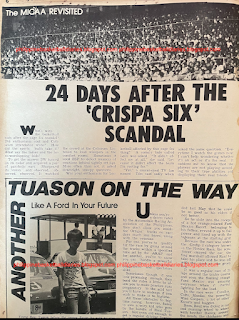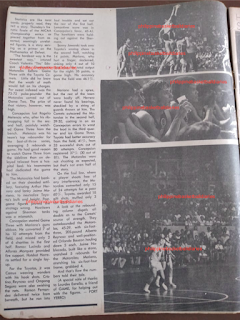Sports World Magazine
September 8, 1973
E.A. Perez de Tagle
It’s what could have been time for the MICAA, and Sports World pinpoints five incidents which in no little way contributed to Toyota’s magnificent triumph in its maiden year and only in its third tournament (including the time it played as Komatsu).
These are:
1. The decommissioning of Willie Adornado of Crispa on a fractured left hand for seven games.
2. The banning for life of Rudy Soriano and Rey Franco of Crispa.
3. “Lax officiating” in the second game between YCO and Universal Textile.
4. Orly Bauzon’s “Shot of the Year” without which Toyota would have made an early exit during the Comets’ semifinal playoff with San Miguel Corporation.
5. Roger Melencio’s suffering a fractured rib in the second game of the championship series and his being lost to the Concepcion cause in the rubber match.
The 1973 MICAA campaign was, as far as memory serves, the most extensive, with two round-robins among 10 teams for an average of 18 games per team. As recounted in last week’s issue, Manila Bank played 15 and forfeited three, Squibb, CFC, Crispa, Mariwasa and U/Tex with 18 each: SMC 22, Yco 23, and both Toyota and Concepcion 24 each.
During which Mariwasa, the defending champion, strung up five wins in a row only to lose eight of its nine succeeding games including a 95-85 upset by Manilabank and finish seventh from the top. And Ciso Bernardo’s Consolidated Foods Corporation quintet upset SMC, 87-80 only to yield to Squibb’s only victory in the campaign in the Prestos’ very next outing by 92-91.
As the semifinalists took over, Squibb stood at 1-17, Manilabank 3-15, CFC 4-14, Mariwasa 8-10, Crispa 10-8 and U/Tex 11-7.
Crispa was the antonym of luck personified. With four wins behind them, the Redmanizers were leading the Concepcion Motorolas when Bogs Adornado tripped off Jimmy Noblezada. The resulting fall fractured Adornado’s left hand and Crispa went on to lose the game and five of their next seven.
Then, with Adornado back in the lineup and the Crispans still in contention, Rudy Soriano and Rey Franco were adjudged guilty of point-shaving in games played during the MICAA All-Filipino and they joined six other Crispans previously banned for life in the sidelines. Without them, Crispa lost two of its last three games and finished two games out of fourth place.
Note that before the Adornado disaster, the Redmanizers had whipped Toyota, 80-78 and YCO, 81-69; that Danny Floro’s charges only lost to SMC in overtime, 88-86 (with Soriano and SMC’s Boy Velasco being thrown out of the game for exchanging blows, each getting automatic three-game suspensions), and by 94-92 the next time around. (Crispa’s luck continued to sour even after the league ended. One of its mainstays, Fortunato Co, was found guilty of point-shaving and joined the ranks of the banned. Comparatively luckier were Jesse Sullano of Mariwasa and Ramon Lucindo of Concepcion, who each drew one-year suspensions for failing to notify basketball authorities of attempts to bribe them into shaving points.)
Crispa with an intact lineup would have been a tough match for any MICAA team.
U/Tex had the bad luck of starting off against top competition and lost four in a row before notching a first win. It was 4-5 coming home, when the Weavers started playing the games of their lives. First, Concepcion 81-78, next Toyota 82-76, then SMC 78-71.
U/Tex was in the process of adding YCO to its list of victims when Coach Lauro Mumar at a crucial point of the game recalled son Lawrence to the bench and kept him there. Without Larry, the Weavers fast lost ground and U/Tex absorbed one of only two defeats in second-time-around play.
Mumar explained afterwards that he took Larry out “to save him from mayhem.”
U/Tex finished a win shy of figuring in a fourth place playoff with Concecpion and SMC, and the last was seen – for the tournament – of Bay Mumar’s patented slowbreak tactics.
The Braves were ahead, 76-75, with seven seconds to play when the Comets made their last play. It was the second game of the semifinal playoff between SMC and Toyota, with the Braves toting a 70-62 first win. Alberto Reynoso dribbled toward goal and the SMC defense drifted with him. Reynoso passed back, to Orly Bauzon. With the big bulk of Big Boy as screen, Bauzon had a clear view of the basket. He jumped, and his basket in the last four seconds of play gave Toyota a 77-76 victory.
Toyota was back in the race, and there was no stopping the Comets from there.
(Joy) Dionisio did a Bauzon in the second game of the championship playoff series to give Concepcion a 73-72 triumph. The shot also came in the last four seconds, a lay-in after Dionisio managed to spin away from Bauzon.
But Melencio was under an x-ray apparatus at the Makati Medical Center and the attending doctor’s worst fear was realized: the 10th rib on the left side was fractured. He had rammed against the massive leg of Big Boy on a lay-up and crashed to the floor with a thud.
Without Melencio, the Concepcion defense lost cohesiveness and the triumvirate of Big Boy Reynoso, Ed Camus and Mon Fernandez dominated the backboards in the finale, and only Concepcion obstinacy and never-say-die spirit made it a game until the last quarter when the Comets decisively pulled away.















